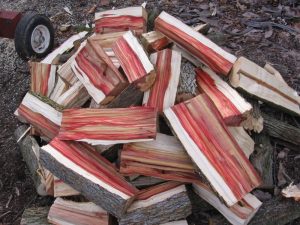Is Box Elder Good for Firewood – Burning Questions About Box Elder
Box elder trees are quite common. You can find these trees in planting zones from 2 to 10 and in a wide variety of soils. As long as they get plenty of sun, these trees can quickly grow to 20 feet in height.

Heat Output and Efficiency (in BTUs)
You can expect around 18 million BTUS per cord of box elder. This wood is not ideal for those who need to fight extreme winter cold. However, box elder logs can be a good choice for fall and spring. Do be aware that this tree can actually be very tough to split when wet.
The growth habit of a box elder is quick. It’s not uncommon for these trees to twist as they grow. Splitting twisted wood can be quite difficult as it can be prone to tipping off the splitting block.
If your woodlot or wood supply team has access to a lot of box elder logs, it may be time to invest in a splitter to reduce the risks that an ax can bring. Another good option is to get your rounds cut a bit shorter than the standard 16 inches.
Creosote Buildup
Box elder logs tend to produce a fair amount of smoke. This smoke will increase the particulate that builds up inside the chimney. This wood burns quite hot and is quickly reduced to ashes.
To avoid excess particulate in your chimney, you may want to pair box elder with a higher BTU firewood, such as oak or maple. Your box elder firewood, split small, may be an ideal base layer while your oak logs catch and increase both the heat of your fire and the coal production.
Before fire season, do go to the trouble to get your chimney cap checked and your chimney thoroughly swept. If your home is far off the beaten path, this can also be a good time to check your chimney for guests, such as birds. One bird’s nest in a chimney can impact air flow and even lead to a dangerous chimney fire.
Amount of Smoke, Spark, and Coal Production
While box elder firewood often produces more smoke than other wood with a similar heat output, this firewood burns fairly quiet and calm. If you don’t like the scent of box elder burning inside your house, you can use this outside to use in a firepit with little risk of spitting and sparking.
If you fire up some box elder wood and find the smell is quite unpleasant, it probably needs more seasoning time. This wood will be much lighter to handle when it’s fully seasoned and ready to burn. Do be aware that it will be tougher to split once it’s fully seasoned. Try to split it close to the cutting time when possible.
How Long Does Box Elder Firewood Need to Season?
Box elder needs to season for at least 6 months. Depending on the moisture in the air, it’s a good idea to set your box elder logs in a spot that gets a lot of sun and wind. Put stringers down or use a pallet to keep this wood off the ground. The bark on box elder wood is smooth on new growth, but older growth features deep ridges.
If you can give it 8 months to cure, you’ll get a much cleaner burn. For those who manage their own woodlots, it may be a good idea to take down the box elders closest to your home to start. Box elder bugs thrive on the living trees. They will also be very happy living in your home when the weather grows cold.
You can pay to have the trees sprayed for larvae before summer temperatures rise. However, because box elder bugs don’t harm the trees, it can be hard to tell which tree is infested. The treatment may be cost-prohibitive if you have many box elder trees.
While these bugs won’t hurt the trees or damage your house, they are smelly when smashed. To keep them out of your home naturally, try planting mums under the windows and around doors where box elder bugs will try to sneak in. Put out dried lavender and whole cloves to repel them from inside your home. Finally, if you find box elder bugs in your house, vacuum them up instead of crushing them.
Is Box Elder Firewood Expensive?
Box elder firewood is generally some of the cheapest firewood you can find. These trees may actually be considered weeds in some woodlots. Many woodsmen may be trying to get them out of their woodlots and yards because of the bugs. Box elder trees can also grow quite brittle and drop branches in high summer.
If you are not confident with an ax and don’t have a splitter, find out if your favorite woodsman can help you out to split these logs. They are quite fibrous and may not grow straight enough to split easily.
Pros and Cons of Using Box Elder for Firewood
Pros:
- Box elder firewood can be low in cost
- This firewood is fairly calm when burning; you won’t be dealing with a lot of popping or sparking
- The maximum seasoning time necessary for this firewood is 8 months. If you cut in the spring, you can burn this in the fall before winter temperatures drop
Cons:
- Box elder trees can be extremely messy in your yard or your woodlot, dropping seeds in spring, branches in summer and brown leaves in the fall
- The bugs that feed on box elders can be quite bothersome
- Even cured, this firewood is fairly smoky
How Box Elder Firewood Compares to Other Trees
A good wood to compare box elder to is cottonwood. Both are trees that thrive along waterways. Both have a fairly low BTU output, though cottonwood burns a bit warmer. Both are fibrous and tough to split when freshly cut.
While cottonwood takes longer to season, it is much easier to split once it has started to season. Both burn quiet when fully cured, but box elder generates more smoke. Cottonwood is also likely to have a much straighter grain when splitting, reducing the effort you have to put into cutting it into usable logs. As noted above, box elder is prone to twisting.
If you or your local woodsman are cleaning up a woodlot, box elder trees will likely be some of the first to go. Keep them away from your home to reduce the invasion of box elder bugs inside your space. Be aware that there are many birds and mammals that feed from the seeds of the box elder tree in the spring.
The branch dropping habit of the box elder tree can be problematic for those who are learning to manage their own woodlot. Under a fall of leaves, these branches can become serious tripping hazards. If you’re taking down one of these trees, make sure you clear a space under and around the tree so you’ll have a safe escape if the felling process runs into any challenges.


